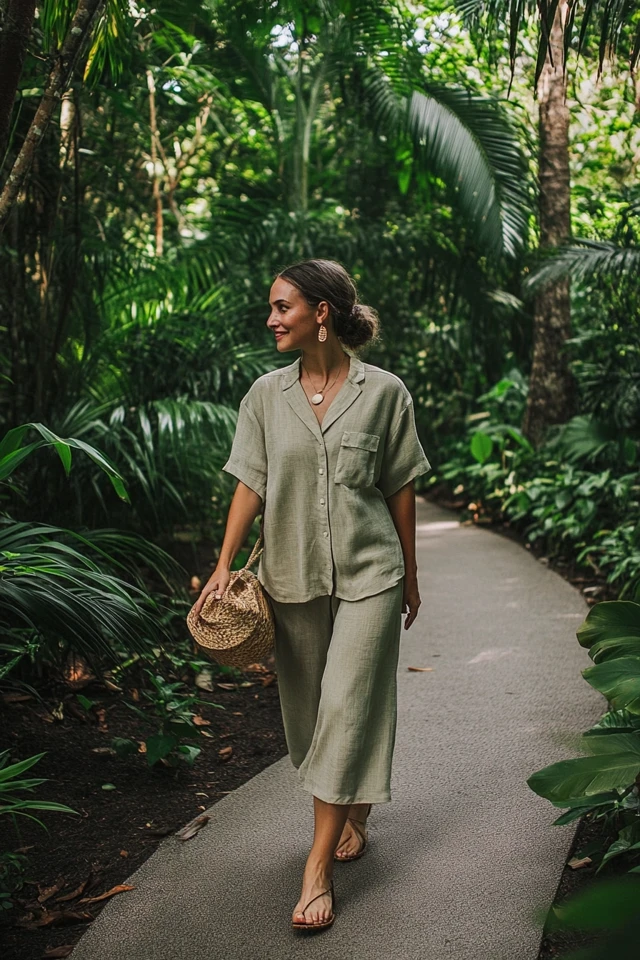Living in or visiting a humid climate can be both exhilarating and challenging. The lush greenery, vibrant cultures, and warm temperatures create a unique environment that demands a thoughtful approach to fashion. Balancing comfort and style in the sticky heat is no small feat, but with the right strategies, you can stay cool and look fabulous all year round. In this blog post, we’ll explore essential fashion tips for humid climates, share a personal anecdote that highlights the importance of smart dressing, and provide practical advice to help you navigate the humidity with ease and flair.
The Sizzle and Style of Humid Climates
Humid climates are characterized by high levels of moisture in the air, which can make temperatures feel hotter and more oppressive. Whether you’re navigating the bustling streets of a tropical city, lounging on a sun-soaked beach, or working in a humid office environment, dressing appropriately is crucial for maintaining comfort and confidence. The right clothing can help regulate your body temperature, wick away sweat, and protect you from the sun, all while keeping you stylish and on-trend.
About the Author and My Trend Boutique
A Personal Anecdote: The Day I Learned to Embrace Humidity
A few summers ago, I found myself relocating to a vibrant coastal city known for its sultry summers and relentless humidity. Excited for the adventure, I packed my usual wardrobe of heavy fabrics and layered outfits, confident that I could adapt. However, within days, I was battling excessive sweat, sticky clothes, and the constant discomfort of overheating. My once stylish ensembles became sources of irritation rather than confidence boosters.
Determined to find a solution, I embarked on a mission to revamp my wardrobe with breathable, lightweight fabrics and versatile pieces tailored for humid conditions. The transformation was remarkable—not only did I feel more comfortable, but I also discovered a new sense of style that embraced the unique demands of the climate. This experience taught me invaluable lessons about dressing for humidity, which I’m excited to share with you.
Understanding the Science of Humidity and Fashion
Humid climates present specific challenges that influence how we choose our clothing. Understanding the interplay between humidity, sweat, and fabric can help you make informed decisions that enhance both comfort and style.
1. Fabric Matters
The type of fabric you choose plays a significant role in how you feel in humid weather. Breathable, lightweight materials allow air to circulate, helping to evaporate sweat and keep you cool.
- Natural Fibers: Linen, cotton, and bamboo are excellent choices as they are highly breathable and absorb moisture well.
- Performance Fabrics: Modern synthetic fabrics like polyester blends and moisture-wicking materials are designed to draw sweat away from the body, keeping you dry and comfortable.
- Avoid Heavy Fabrics: Materials like denim, wool, and thick knits can trap heat and moisture, leading to discomfort and excessive sweating.
2. Color Psychology
Colors not only reflect personal style but also impact how you feel in different environments. Light colors are particularly beneficial in humid climates.
- Light Colors: Whites, pastels, and neutrals reflect sunlight, helping to keep you cooler by absorbing less heat.
- Dark Colors: While chic, dark colors absorb more heat and can make you feel hotter. If you prefer darker hues, consider wearing them in breathable fabrics or incorporating them as accents rather than primary pieces.
3. Fit and Functionality
The fit of your clothing can significantly influence your comfort levels in humid conditions. Loose-fitting garments promote airflow, while tight-fitting clothes can restrict movement and trap heat.
- Loose-Fitting: Flowing dresses, wide-leg pants, and oversized shirts allow for better ventilation and reduce the likelihood of sweat buildup.
- Tailored Fit: If you prefer a more fitted look, opt for garments that are tailored but not restrictive, ensuring they don’t cling excessively to your skin.
Mastering Humid Climate Fashion: Practical Tips
Armed with an understanding of how humidity affects your clothing choices, let’s dive into some practical tips to help you stay cool and stylish.
1. Choose the Right Fabrics
Selecting the appropriate fabrics is the cornerstone of dressing for humid climates. Here’s how to make the best choices:
- Linen: Known for its breathability and moisture-wicking properties, linen is perfect for both casual and formal wear. Its lightweight nature allows air to flow freely, keeping you cool.
- Cotton: Soft, breathable, and highly absorbent, cotton is a staple for humid weather. Opt for lightweight cotton blends to enhance comfort.
- Bamboo: An eco-friendly option, bamboo fabric is breathable, moisture-wicking, and has natural antibacterial properties, making it ideal for hot and sticky days.
- Performance Blends: Fabrics engineered with moisture-wicking technology help keep sweat at bay, ensuring you stay dry and comfortable.
Pro Tip: Mix and match different fabrics within your wardrobe to maximize comfort and versatility.
2. Embrace Light Colors and Patterns
Light-colored clothing reflects sunlight, helping to keep you cooler. Additionally, strategic use of patterns can enhance your style without overwhelming the look.
- Whites and Neutrals: These colors are timeless and versatile, easily paired with other hues and suitable for various occasions.
- Pastels: Soft colors like light blue, mint green, and blush pink add a fresh, summery vibe to your outfits.
- Subtle Patterns: Opt for delicate prints such as small florals, stripes, or polka dots to add visual interest without the heat absorption of darker, bold patterns.
Pro Tip: Incorporate vibrant colors through accessories like scarves, hats, and jewelry to add a pop of color without the added heat.
3. Prioritize Breathable Footwear
Your choice of footwear can make a significant difference in your overall comfort during humid weather.
- Open-Toe Shoes: Sandals, espadrilles, and open-toe heels allow your feet to breathe and reduce sweat buildup.
- Breathable Materials: Look for shoes made from lightweight, breathable materials like canvas, mesh, or perforated leather.
- Comfortable Soles: Choose footwear with cushioned soles and good arch support to prevent discomfort during long days on your feet.
Pro Tip: Rotate your shoes regularly to allow them to air out and prevent odor buildup.
4. Opt for Loose and Flowing Silhouettes
Loose-fitting clothing promotes airflow, which helps regulate your body temperature and reduces the likelihood of excessive sweating.
- Maxi Dresses and Skirts: These offer elegance and comfort, allowing air to circulate freely around your legs.
- Wide-Leg Pants: Perfect for both casual and professional settings, wide-leg pants provide a breezy alternative to tight jeans.
- Oversized Shirts and Blouses: These pieces can be tucked into skirts or pants for a polished look while maintaining comfort.
Pro Tip: Experiment with different silhouettes to find what works best for your body type and personal style.
5. Incorporate Lightweight Layers
While it may seem counterintuitive, lightweight layers can be beneficial in humid climates, especially during cooler evenings or air-conditioned environments.
- Thin Cardigans or Kimonos: These can be easily removed when you’re warm and added when the temperature drops.
- Light Scarves: Not only do they add a stylish touch, but they can also provide a bit of coverage without adding bulk.
- Breathable Jackets: Choose jackets made from lightweight, breathable materials like cotton or linen blends.
Pro Tip: Select layers that can be easily mixed and matched with your existing wardrobe to enhance versatility.
6. Invest in Quality Undergarments
The foundation of staying comfortable in humid climates starts with your undergarments. Opt for pieces that prioritize breathability and moisture-wicking properties.
- Seamless Bras: These reduce friction and discomfort, allowing for better airflow.
- Moisture-Wicking Underwear: Fabrics like bamboo or performance blends help keep you dry and comfortable.
- Lightweight Camisoles: These can act as a base layer, providing an extra layer of comfort without adding heat.
Pro Tip: Choose neutral colors for undergarments to ensure they remain invisible under your clothing.
7. Accessorize Thoughtfully
Accessories can enhance your outfits while providing practical benefits in humid climates.
- Wide-Brimmed Hats: These offer excellent sun protection and add a stylish element to your look.
- Sunglasses: Protect your eyes from harmful UV rays and add a touch of sophistication.
- Lightweight Bags: Opt for breathable materials like canvas or straw to keep your belongings cool and reduce sweat buildup.
- Breathable Jewelry: Choose minimalistic and lightweight pieces to avoid discomfort and excessive sweating.
Pro Tip: Select accessories that complement your outfit’s color palette to create a cohesive and polished appearance.
Picture Gallery
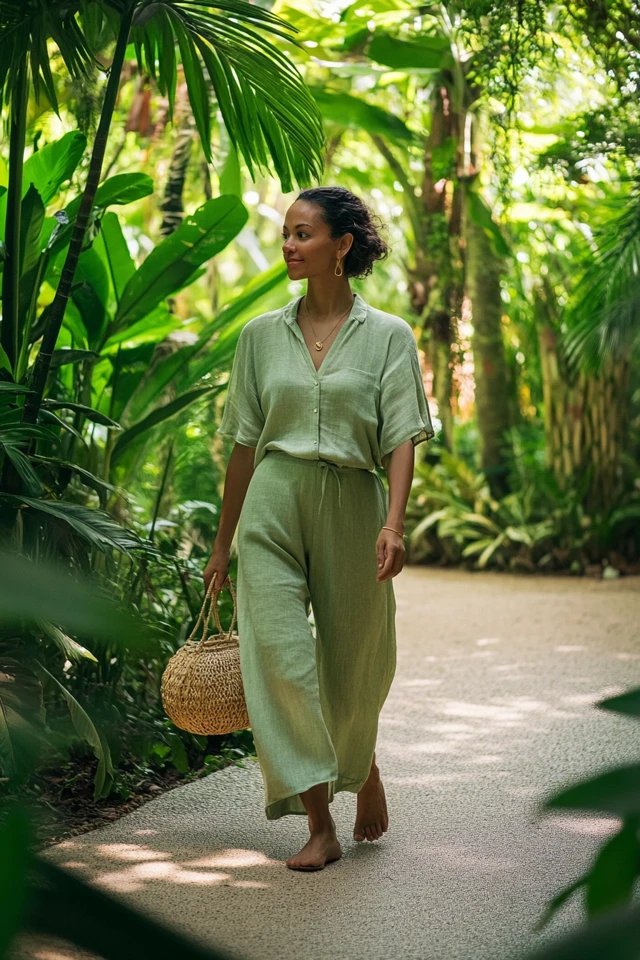
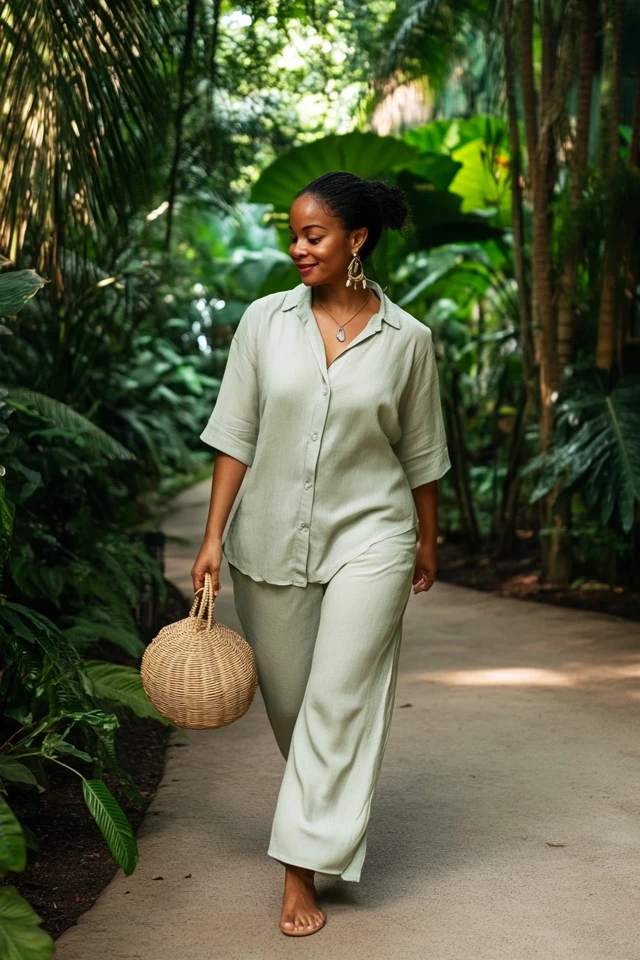
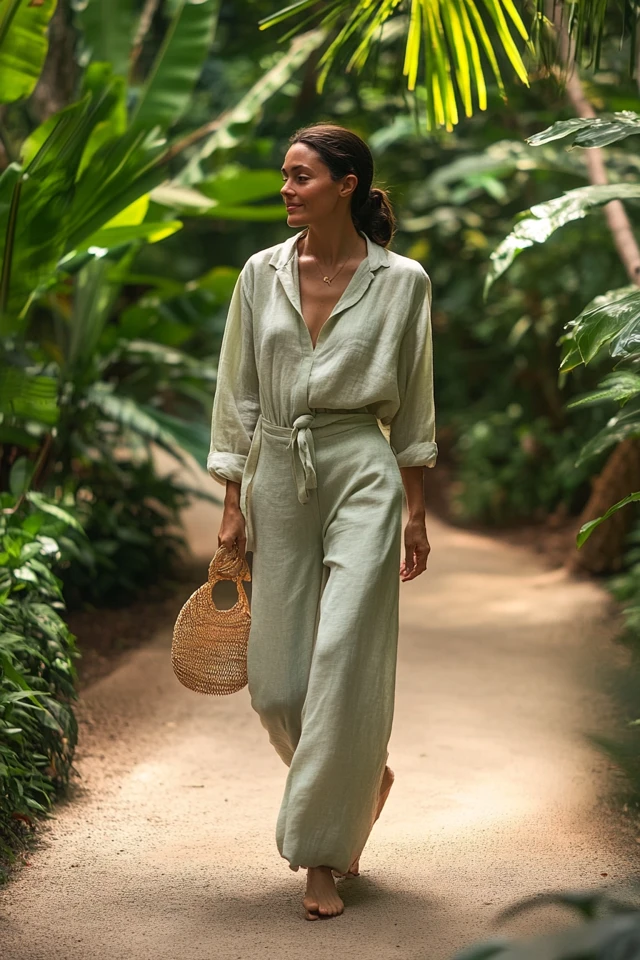



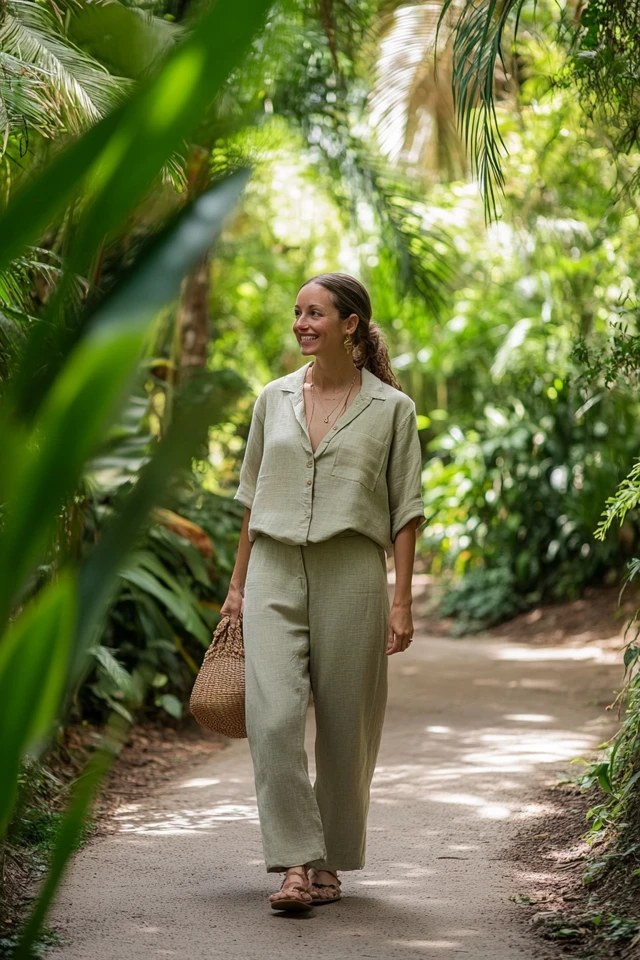
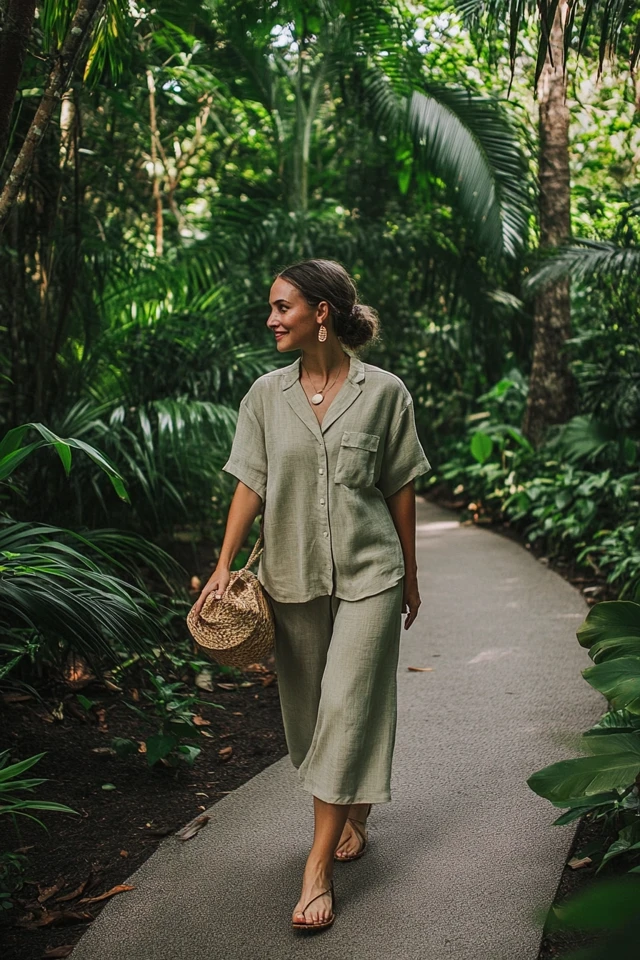
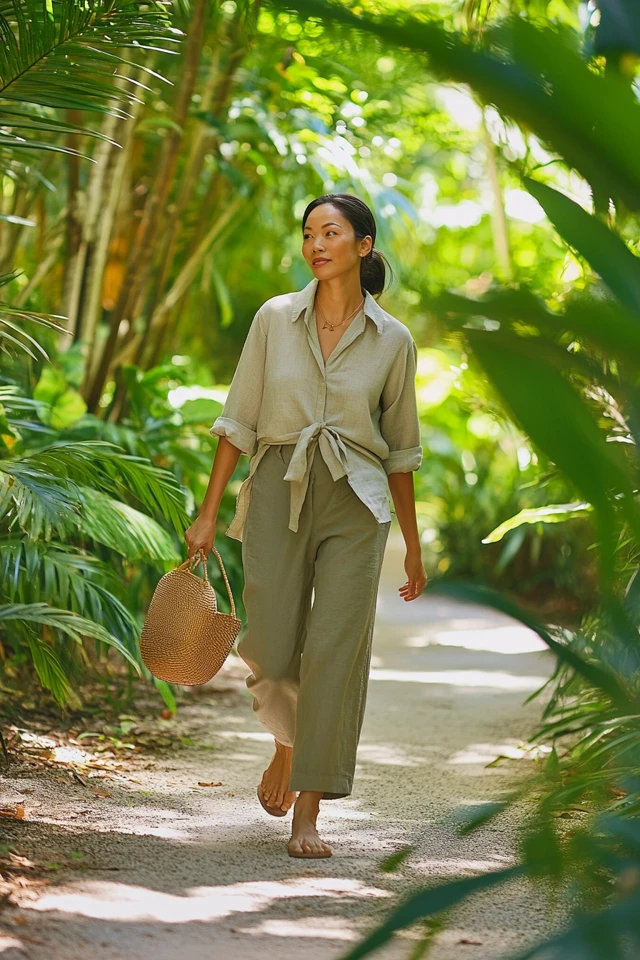
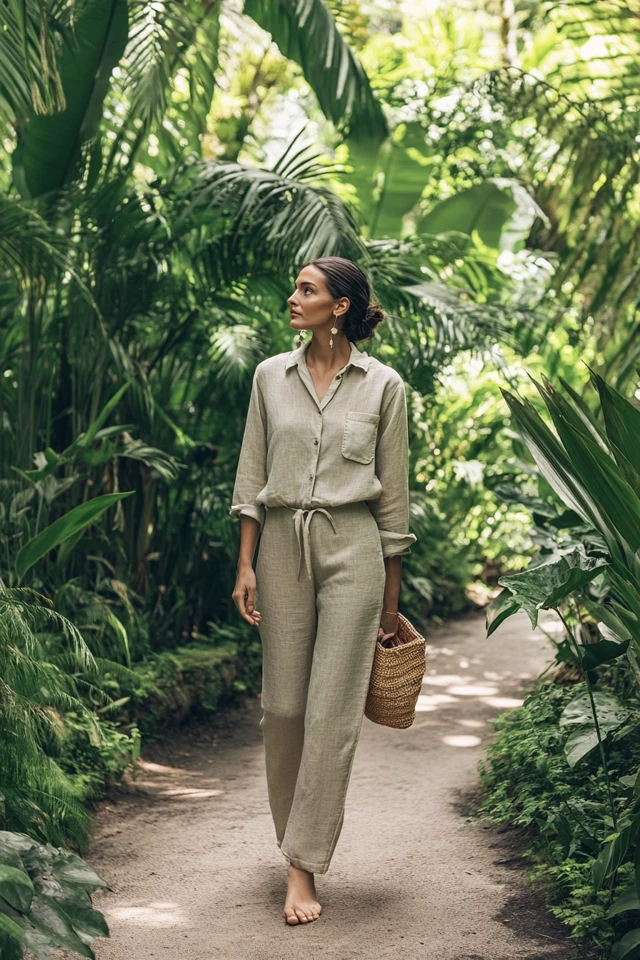
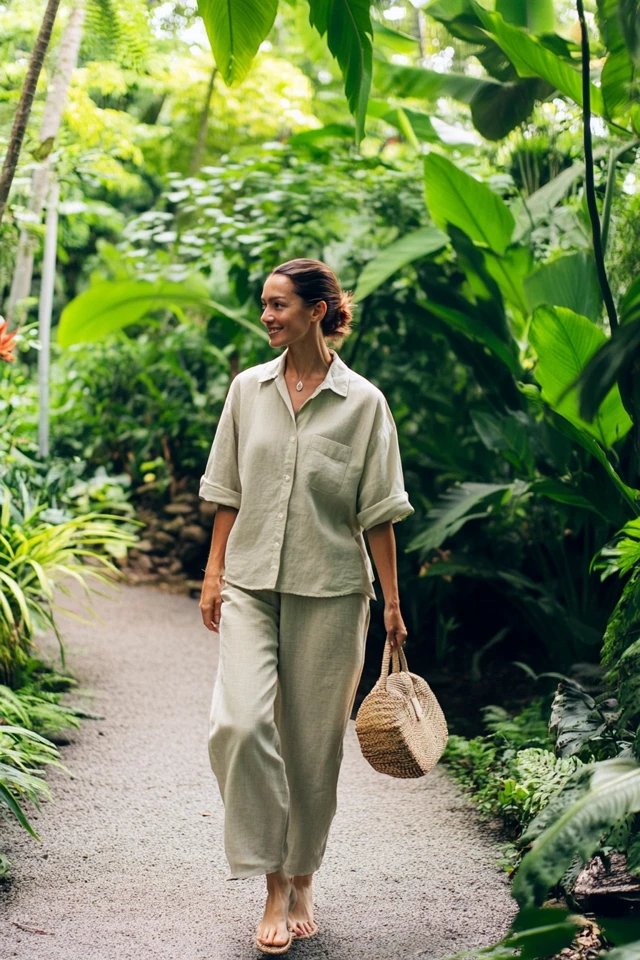
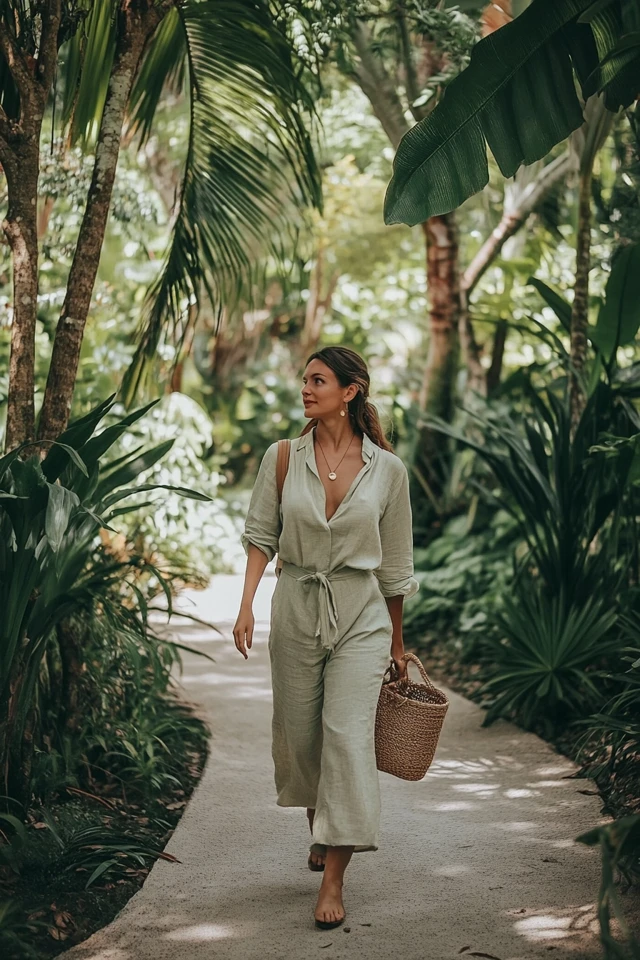
Adapting Your Wardrobe for Different Activities
Humid climates often come with a variety of activities, each requiring specific wardrobe considerations. Here’s how to tailor your fashion choices to suit various pursuits:
For Office and Professional Settings
Maintaining a professional appearance in a humid climate can be challenging, but with the right pieces, you can stay cool and stylish.
- Lightweight Blazers: Choose blazers made from breathable fabrics like linen or cotton blends.
- Breathable Dresses: Opt for knee-length or midi dresses in moisture-wicking materials.
- Loosen Up Trousers: Wide-leg or palazzo pants offer a polished look while providing airflow.
Pro Tip: Incorporate moisture-wicking undershirts to stay dry and comfortable throughout the workday.
For Outdoor Adventures
Whether you’re hiking, exploring, or engaging in other outdoor activities, dressing appropriately is essential for both comfort and performance.
- Performance Tops: Choose moisture-wicking, breathable shirts that keep you dry during physical exertion.
- Quick-Dry Shorts or Pants: Lightweight, durable fabrics that dry quickly after sweating or unexpected rain.
- Breathable Footwear: Hiking shoes or sandals with good ventilation to keep your feet cool.
Pro Tip: Wear a hat with a brim and UV-protective sunglasses to shield yourself from the sun during outdoor activities.
For Casual Outings
Staying comfortable and stylish during casual outings in humid climates is all about choosing the right pieces.
- Flowy Tops and Blouses: These allow for easy movement and breathability.
- Casual Dresses: Sundresses or wrap dresses in lightweight fabrics are perfect for relaxed settings.
- Comfortable Footwear: Sneakers, flats, or casual sandals keep your look effortless and comfortable.
Pro Tip: Incorporate playful patterns and vibrant colors to enhance your casual outfits without adding heat.
For Evening and Nightlife
Evening outings in humid climates often require a balance of style and comfort, especially as temperatures can remain warm after dark.
- Chic Maxi Dresses: Elegant and breathable, perfect for evening gatherings.
- Lightweight Jumpsuits: Offer a stylish alternative to dresses while remaining comfortable.
- Breathable Fabrics: Opt for materials like silk or lightweight cotton that feel cool against the skin.
Pro Tip: Accessorize with statement jewelry or a stylish clutch to elevate your evening look without adding bulk.
For Travel and Sightseeing
When exploring new places, comfort and functionality are key to enjoying your travels in humid climates.
- Versatile Dresses and Skirts: Easy to mix and match with different tops and accessories.
- Comfortable Footwear: Choose shoes that are easy to walk in and dry quickly if you encounter unexpected weather.
- Lightweight Outerwear: A breathable cardigan or shawl for air-conditioned environments or cooler evenings.
Pro Tip: Pack a foldable fan or handheld misting spray to stay cool during long days of sightseeing.
Sustainable Fashion: Eco-Friendly Choices for Humid Climates
Sustainability is an important consideration in any wardrobe, and dressing for humid climates offers unique opportunities to embrace eco-friendly fashion practices.
1. Choose Sustainable Fabrics
Opting for environmentally friendly materials not only benefits the planet but also enhances your comfort in humid conditions.
- Organic Cotton: Grown without harmful pesticides, making it a sustainable and breathable choice.
- Bamboo: An eco-friendly fabric that is soft, breathable, and moisture-wicking.
- Recycled Materials: Fabrics made from recycled polyester or nylon reduce waste and conserve resources.
Pro Tip: Look for certifications like GOTS (Global Organic Textile Standard) to ensure the authenticity of sustainable fabrics.
2. Invest in High-Quality, Durable Clothing
High-quality garments last longer, reducing the need for frequent replacements and minimizing waste.
- Timeless Pieces: Choose classic styles that remain fashionable across seasons.
- Durable Fabrics: Select materials that can withstand the rigors of humid climates without deteriorating quickly.
Pro Tip: Prioritize versatility in your wardrobe to maximize the use of each piece and reduce the need for additional items.
3. Support Ethical Brands
Choose brands that prioritize ethical manufacturing practices and environmental sustainability.
- Transparent Supply Chains: Brands that disclose their production processes ensure ethical standards are met.
- Fair Labor Practices: Support companies that treat their workers fairly and provide safe working conditions.
Pro Tip: Research brands’ sustainability practices and opt for those committed to reducing their environmental impact.
4. Embrace Minimalism
Adopting a minimalist approach reduces clutter and encourages mindful consumption.
- Capsule Wardrobe: Create a capsule wardrobe with versatile, interchangeable pieces that maximize outfit options.
- Quality Over Quantity: Focus on owning fewer, high-quality items rather than an abundance of low-quality clothing.
Pro Tip: Regularly assess your wardrobe and donate or recycle items you no longer need or wear.
5. Care for Your Clothing Properly
Proper maintenance extends the life of your garments, reducing the need for replacements and minimizing environmental impact.
- Follow Care Instructions: Adhere to washing and drying guidelines to preserve fabric integrity.
- Repair When Needed: Mend small tears or replace missing buttons to keep your clothing in good condition.
Pro Tip: Invest in eco-friendly laundry detergents and practices that minimize water and energy usage.
6. Repurpose and Upcycle
Give new life to old clothing by repurposing or upcycling.
- Creative Alterations: Transform outdated pieces into trendy new items through sewing or DIY projects.
- Accessory Creation: Use fabric scraps to create accessories like scarves, headbands, or bags.
Pro Tip: Explore online tutorials and communities for inspiration and guidance on upcycling projects.
Style Tips for Staying Cool and Chic
Achieving a stylish look while staying cool in humid climates is entirely possible with these additional style tips:
1. Mix Textures and Patterns
Incorporate different textures and subtle patterns to add depth and interest to your outfits.
- Textured Fabrics: Combine smooth linen with textured knits or embroidered details for a visually appealing ensemble.
- Subtle Patterns: Opt for delicate prints like stripes, florals, or geometric designs that evoke a sense of lightness and airiness.
Pro Tip: Balance bold patterns with solid-colored pieces to avoid overwhelming your look.
2. Play with Silhouettes
Experiment with various silhouettes to create dynamic and flattering outfits.
- Maxi Dresses and Skirts: Flowing silhouettes offer both style and comfort, perfect for humid weather.
- Wide-Leg Pants: Provide breathability and a sophisticated appearance, ideal for both casual and professional settings.
Pro Tip: Layer different silhouettes, such as a fitted top with a flowing skirt, to create contrast and visual interest.
3. Incorporate Statement Pieces
Elevate your wardrobe with standout items that showcase your personal style.
- Statement Jewelry: Bold necklaces, oversized earrings, or stacked bracelets can add a touch of glamour.
- Unique Footwear: Choose shoes with intricate designs or vibrant colors to make a statement.
Pro Tip: Use statement pieces sparingly to enhance your outfit without overpowering it.
4. Choose Functional yet Fashionable Bags
A stylish bag can be both a fashion statement and a practical accessory.
- Crossbody Bags: Convenient for keeping essentials accessible during your adventures.
- Backpacks: Ideal for hands-free carrying and distributing weight evenly.
Pro Tip: Select bags made from durable, lightweight materials that complement your overall look.
5. Opt for Minimalist Designs
Sometimes, less is more. Minimalist designs can create an elegant and timeless look suitable for humid climates.
- Clean Lines and Simple Cuts: Focus on well-tailored pieces that emphasize your silhouette without adding unnecessary bulk.
- Monochromatic Outfits: Create a sleek and sophisticated appearance with a single color palette.
Pro Tip: Add interest through textures and subtle details rather than relying on bold colors or patterns.
Adapting Your Wardrobe for Different Activities
Humid climates often come with a variety of activities, each requiring specific wardrobe considerations. Here’s how to tailor your fashion choices to suit various pursuits:
For Office and Professional Settings
Maintaining a professional appearance in a humid climate can be challenging, but with the right pieces, you can stay cool and stylish.
- Lightweight Blazers: Choose blazers made from breathable fabrics like linen or cotton blends.
- Breathable Dresses: Opt for knee-length or midi dresses in moisture-wicking materials.
- Loosen Up Trousers: Wide-leg or palazzo pants offer a polished look while providing airflow.
Pro Tip: Incorporate moisture-wicking undershirts to stay dry and comfortable throughout the workday.
For Outdoor Adventures
Whether you’re hiking, exploring, or engaging in other outdoor activities, dressing appropriately is essential for both comfort and performance.
- Performance Tops: Choose moisture-wicking, breathable shirts that keep you dry during physical exertion.
- Quick-Dry Shorts or Pants: Lightweight, durable fabrics that dry quickly after sweating or unexpected rain.
- Breathable Footwear: Hiking shoes or sandals with good ventilation to keep your feet cool.
Pro Tip: Wear a hat with a brim and UV-protective sunglasses to shield yourself from the sun during outdoor activities.
For Casual Outings
Staying comfortable and stylish during casual outings in humid climates is all about choosing the right pieces.
- Flowy Tops and Blouses: These allow for easy movement and breathability.
- Casual Dresses: Sundresses or wrap dresses in lightweight fabrics are perfect for relaxed settings.
- Comfortable Footwear: Sneakers, flats, or casual sandals keep your look effortless and comfortable.
Pro Tip: Incorporate playful patterns and vibrant colors to enhance your casual outfits without adding heat.
For Evening and Nightlife
Evening outings in humid climates often require a balance of style and comfort, especially as temperatures can remain warm after dark.
- Chic Maxi Dresses: Elegant and breathable, perfect for evening gatherings.
- Lightweight Jumpsuits: Offer a stylish alternative to dresses while remaining comfortable.
- Breathable Fabrics: Opt for materials like silk or lightweight cotton that feel cool against the skin.
Pro Tip: Accessorize with statement jewelry or a stylish clutch to elevate your evening look without adding bulk.
For Travel and Sightseeing
When exploring new places, comfort and functionality are key to enjoying your travels in humid climates.
- Versatile Dresses and Skirts: Easy to mix and match with different tops and accessories.
- Comfortable Footwear: Choose shoes that are easy to walk in and dry quickly if you encounter unexpected weather.
- Lightweight Outerwear: A breathable cardigan or shawl for air-conditioned environments or cooler evenings.
Pro Tip: Pack a foldable fan or handheld misting spray to stay cool during long days of sightseeing.
Sustainable Fashion: Eco-Friendly Choices for Humid Climates
Sustainability is an important consideration in any wardrobe, and dressing for humid climates offers unique opportunities to embrace eco-friendly fashion practices.
1. Choose Sustainable Fabrics
Opting for environmentally friendly materials not only benefits the planet but also enhances your comfort in humid conditions.
- Organic Cotton: Grown without harmful pesticides, making it a sustainable and breathable choice.
- Bamboo: An eco-friendly fabric that is soft, breathable, and moisture-wicking.
- Recycled Materials: Fabrics made from recycled polyester or nylon reduce waste and conserve resources.
Pro Tip: Look for certifications like GOTS (Global Organic Textile Standard) to ensure the authenticity of sustainable fabrics.
2. Invest in High-Quality, Durable Clothing
High-quality garments last longer, reducing the need for frequent replacements and minimizing waste.
- Timeless Pieces: Choose classic styles that remain fashionable across seasons.
- Durable Fabrics: Select materials that can withstand the rigors of humid climates without deteriorating quickly.
Pro Tip: Prioritize versatility in your wardrobe to maximize the use of each piece and reduce the need for additional items.
3. Support Ethical Brands
Choose brands that prioritize ethical manufacturing practices and environmental sustainability.
- Transparent Supply Chains: Brands that disclose their production processes ensure ethical standards are met.
- Fair Labor Practices: Support companies that treat their workers fairly and provide safe working conditions.
Pro Tip: Research brands’ sustainability practices and opt for those committed to reducing their environmental impact.
4. Embrace Minimalism
Adopting a minimalist approach reduces clutter and encourages mindful consumption.
- Capsule Wardrobe: Create a capsule wardrobe with versatile, interchangeable pieces that maximize outfit options.
- Quality Over Quantity: Focus on owning fewer, high-quality items rather than an abundance of low-quality clothing.
Pro Tip: Regularly assess your wardrobe and donate or recycle items you no longer need or wear.
5. Care for Your Clothing Properly
Proper maintenance extends the life of your garments, reducing the need for replacements and minimizing environmental impact.
- Follow Care Instructions: Adhere to washing and drying guidelines to preserve fabric integrity.
- Repair When Needed: Mend small tears or replace missing buttons to keep your clothing in good condition.
Pro Tip: Invest in eco-friendly laundry detergents and practices that minimize water and energy usage.
6. Repurpose and Upcycle
Give new life to old clothing by repurposing or upcycling.
- Creative Alterations: Transform outdated pieces into trendy new items through sewing or DIY projects.
- Accessory Creation: Use fabric scraps to create accessories like scarves, headbands, or bags.
Pro Tip: Explore online tutorials and communities for inspiration and guidance on upcycling projects.
Conclusion: Stay Cool, Look Cool
Navigating the challenges of humid climates doesn’t mean compromising on style. With the right strategies and a thoughtful approach, you can create a wardrobe that keeps you cool, comfortable, and chic. Embrace breathable fabrics, opt for light colors and loose silhouettes, and accessorize thoughtfully to enhance both your comfort and your look. Remember the lessons from my own humid ordeal and equip yourself with the knowledge to make informed fashion choices tailored to the unique demands of humid environments.
By prioritizing sustainability, investing in high-quality pieces, and embracing a minimalist approach, you not only enhance your personal style but also contribute to the preservation of our planet. Whether you’re exploring vibrant cities, lounging on tropical beaches, or navigating everyday life in a humid climate, your wardrobe can be a reflection of both your style and your commitment to comfort and sustainability.
So, dress wisely, stay cool, and let your fashion choices empower you to thrive in the lush, vibrant world of humid climates. Embrace the humidity with confidence and style, and enjoy the dynamic beauty that comes with dressing thoughtfully for the heat.

